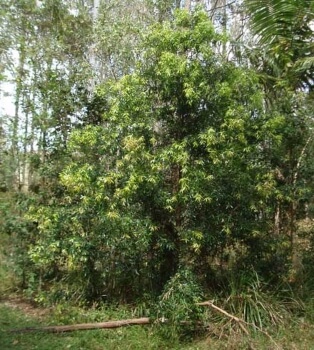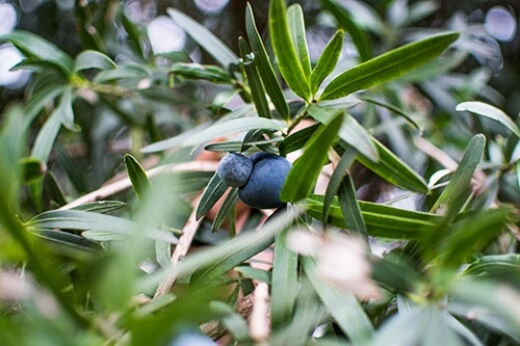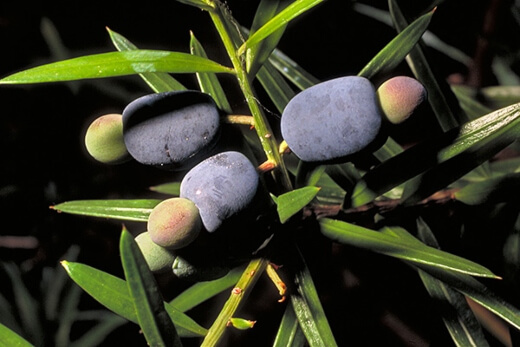Today we’ll be looking at another spectacular native rainforest tree prized for its bush food and landscaping applications, the Illawarra plum tree or Podocarpus elatus.
This medium to large evergreen tree features shiny dark-green lanceolate leaves, blue to purple berry-like fruits and an ideal spreading form for decorative silhouettes within cultivated landscapes.
This beloved ancient species has garnered its reputation over centuries and it’s a pretty straightforward plant to establish in our endemic conditions.
Here is everything you need to know to grow and care for this beautiful native tree in your garden. Enjoy its spectacular presence in your garden by following our easy guide below.
More...
Family: | Podocarpaceae |
|---|---|
Genus: | Podocarpus |
Species: | P. elatus |
Common Names: | Illawarra plum, plum pine, brown pine |
Location: | Outdoor (preferred) |
Type: | Evergreen tree |
Growth: | 8 to 12 metres tall, 4 to 7 metres wide |
Sun requirements: | Full sun to part shade |
Foliage Colour: | Green |
Flower Colour: | Greenish-white (insignificant) |
Flowering: | Summer |
Fruit: | Edible purple to black berries in late summer to autumn |
Maintenance level: | Low |
Poisonous for pets: | Seed pods are toxic to cats and dogs |
Introducing Podocarpus elatus

Source: trolleyd.com.au
This highly attractive ornamental tree can offer growers and homeowners many landscaping applications. Whether you’re looking at establishing a larger tree for shade or as a feature or you’re simply a fan of fruiting natives, the Illawarra plum is certainly a must-have.
Its spreading crown of lush glossy-green evergreen foliage will always impress and boost the tropical appeal of any garden, regardless of the existing setting or décor.
Endemic to the eastern coast of Australia where it occurs predominantly in eastern New South Wales and Queensland, the Illawarra plum tree is scientifically labelled as Podocarpus elatus.
Other common names now include the plum pine or brown pine tree. Despite its name, this tree is not a plum species but rather a conifer which is an ancient family of trees that produce woody seed cones with fruits attached.
Illawarra Plum's Natural Habitat
In its natural habitat, this tree can grow to over 35 metres tall but within cultivated gardens, it will usually reach 8 to 12 metres tall and 4 to 7 metres wide.
This species is slow-growing especially in its initial 1 to 2 years and will normally take about 8 to 10 years to reach its full height. It is important to note that this species is dioecious which means you will need both male and female trees to produce fruits.
Once you have both established, fruits will form from 3 to 5 years onwards on female trees. The fruits will attract local birds, bees, butterflies and other insects.
Plum Pine Common Landscaping Applications
If you’re not too interested in the fruits of Podocarpus elatus, common applications can include use as a specimen or feature tree planted alone. This tree’s canopy is also perfect for use as a shade tree once matured.
For fruiting applications, it is recommended to plant several plants to help ensure you have males and females. Another fantastic option is to plant the trees as fruiting native hedges or screens.


Get Your Free Guide:
Master Growing Australian Natives eBook
A Must Have Complete Guide for Every Australian Garden
Get Your Free Guide:
Master Growing Australian Natives eBook
A Must Have Complete Guide for Every Australian Garden
Perhaps even chat to your neighbours about teaming up and planting a few Illawarra plums in the area to secure pollination for everyone involved.
Planting location will need to be carefully considered if you have roaming pets as the seed pods can be toxic to both cats and dogs if ingested.
How to Grow Podocarpus elatus

Source: gardensonline.com.au
Illawarra plum trees can be grown from both seeds or stem cuttings. Cuttings tend to be easier and more successful and will strike far sooner in your landscape meaning you will have a fruiting specimen far sooner than seed-grown trees.
Alternatively, young and healthy nursery plants are also always a good idea, especially for those who aren’t very comfortable with growing plants from seeds or via propagation.
Either way, follow our simple steps below to grow your tree.
Growing Plum Pine from Seeds
- Soak your seeds in water for a day or two, changing the water regularly.
- Sow the seeds in spring or autumn into seed starter trays filled with a quality seed-raising mix. Sow seeds just below the surface of the mix.
- Place the trays in a warm and sunny location then mist regularly to keep the soil lightly moist but never wet at all times.
- Seeds prefer temperatures between 20 and 24°C.
- Seeds germination can take anywhere from 30 to 90 days depending on conditions.
- Once the seeds have germinated and the seedlings have started establishing themselves, transplant them into larger pots or containers so they can continue developing.
- Once the seedlings have fully developed with healthy roots, you can transplant them into the garden or larger containers for use as potted plants.
Propagating Illawarra Plum from Cuttings
- Take healthy stem cuttings of around 5 to 10 centimetres long in winter using a sharp and sterilised pair of shears or secateurs.
(Check out our review of the best secateurs available for 2024.) - Each cutting should have plenty of leaf nodes.
- Remove the bottom leaves and dip each cutting into a rooting hormone.
- Plant the cuttings into well-draining containers filled with a quality propagating mix or potting soil.
- Place the containers in a warm location with full sun to part shade.
- Mist the cuttings regularly to keep the soil moist but never wet.
- Allow the cuttings to establish themselves and grow healthy roots before transplanting them into the garden or larger containers.
Tips for Planting Nursery Plants
- Be sure your planting hole is at least twice as wide and to the same depth as the root ball of the plant. Choose a spot that gets full sun to part shade daily.
- Dig some organic mulch, compost or manure into the soil before planting.
- Gently remove the young tree from its current container, being careful to disturb the roots as little as possible.
- Gently place the plant into your planting hole, lightly firming the surrounding soil down once in position.
- For the best drainage, consider planting in a raised garden bed.
- Water well after planting.
Best Conditions for Planting Podocarpus elatus

Source: sown.com.au
Whether planted in the garden or a pot, there are certainly some conditions that the Illawarra plum will require to thrive, look its best and fruit as prolifically as possible.
The tree is quite resistant to salty winds as well so it is a great option for coastal gardens. Here are the ideal planting conditions for plum pine:
Ideal Exposure
Being a rainforest tree, full sun to partial shade will be the preferred sunlight exposure for general health, optimal growth and bigger harvests once matured.
For potted indoor trees, be sure to place them close to a window that gets as much daily sunlight as possible.
Best Soil for Illawarra Plum
Rich, moist, non-alkaline soil will be best for Podocarpus elatus but it can tolerate a wide range of soil types including sandy soil, again perfect for coastal regions with warm climates.
Whatever soil you use, just make sure it is well-draining as wet feet can lead to unwanted issues later in the plant’s development.
Preferred Temperature, Climate & Humidity
Most of our endemic conditions should be good enough for the plum pine to grow well. It does prefer mostly subtropical or tropical climates but it can grow in warm temperate regions as well.
The warmer the climate, the better these trees tend to perform in the long run. The tree can withstand temperatures down to around -7°C but not for long periods.
General garden humidity and temperatures in these regions should be enough but if you’re concerned about the moisture levels, you can plant more vegetation around the trees to naturally boost humidity or simply mist occasionally as needed in the warmer months.
Caring for Illawarra Plum

Source: headlands.com.au
Podocarpus elatus is a species that is quite tolerant to drought much like many of its relatives. It is also moderately tolerant to frost for short periods in the winter.
Overall, the tree is pretty self-sufficient and doesn’t require much hassle once established. Here is how you can care for your trees at home:
Watering Schedule
Water regularly while young and during summer. Once matured, your trees should be fairly drought tolerant. If you experience healthy rainfall in the hot months, supplemental watering twice a week should be a good starting point.
Be sure to cut back on waterings in winter to avoid wet feet.
Pruning Podocarpus elatus
Prune regularly as the tree grows to guide its trunk and main branches as needed to have an attractive shape and growth habit. Once growing well, larger trees can be left to grow naturally for the most part.
Trees planted as hedges or screens should be tip pruned regularly to maintain a dense, compact and consistent growth habit. Potted trees will also require more attention to pruning to ensure size and shape are maintained.
Fertilising
Though not necessary, you can feed your trees with organic fertiliser in late winter and summer. Try to use a specialised native plant blend for healthier, more organic harvests.
After fertilising, be sure to delay harvests for a few days and rinse the fruits well before consumption.
Mulching Needs
It is recommended to add a layer of organic mulch around the trees in summer to retain moisture and suppress weeds. Be sure to place the mulch near the trunks but not on them to avoid suffocation at the base.
Illawarra Plum Bush Tucker Guide
The small plum or berry-like fruits are traditionally known as the Daalgaal, Goongum or plum pine which refers to the fruit's pine-like taste. In New South Wales, the Illawarra plum is considered one of the best bush foods by Aboriginal people and European colonists alike.

Source: anpsa.org.au
Podocarpus elatus fruits are made up of two segments – a hard, inedible seed about 1cm in diameter and a large purple-black fleshy berry about 2.5cm in diameter. The fleshy parts of the berries are edible either raw or cooked.
Most choose to consume the fruits by using them in condiments like jams or jellies but they can also be used as fruit-based additions to other dishes, both savoury and sweet.
Eaten raw, the juicy, pulpy fruits have a grape-like texture and a sweetish, mild pine flavour which can be further enhanced by cooking. The fruits are known to contain healthy amounts of antioxidants and vitamin C.
Illawarra plum fruits become ripe between March and July when they can be harvested directly from the trees by picking them or collecting recently fallen ripe fruits from the ground around the trees. Be sure to rinse fruits from the ground well before use.
These tasty fruits are known to complement dishes with chilli and garlic very well. They are especially popular in sauces, marinades, preserves, muffins, cheesecakes and fruit compotes.
When cooking with Illawarra plums, be sure to use stainless steel utensils rather than aluminium to prevent unwanted bitterness.
Here are a few recipes to help get you started:
Common Podocarpus elatus Pests & Diseases
This particular species of rainforest tree is not easily bothered by pest or disease issues. It is a tough, well-adapted and long-lived species that has grown tolerant to many issues that would normally plague other rainforest trees.
This ancient tree originates from around 245 million years ago so it has been around since the dinosaur age. Over that time, very few pests and diseases have been published or sighted on these resilient trees.
In gardens, smaller pests like aphids, scale insects or caterpillars may pose a small problem. Luckily, they can easily be treated by using an organic insecticide or a quality neem oil for plants which can be sprayed to deter these critters.
Overwatering can cause wilting and yellowing foliage as well as root rot so be sure to monitor your soil's moisture closely, especially in the colder winter months.
Podocarpus elatus Frequently Asked Questions

Source: creativenativefoods.com.au
I bought an Illawarra plum tree but it’s not producing fruits. What am I doing wrong?
Being a dioecious species of plant, this tree will need both male and female trees for pollination to occur. It is best to plant several trees to increase the chances of pollination in your landscape.
Fruits will appear on females after about 3 to 5 years onwards.
Do Podocarpus trees have invasive roots?
According to most citations and studies, Podocarpus elatus is not considered an invasive species and it does not produce destructive root systems. It also has no pest or disease issues of concern.
How do I make my Podocarpus thicker?
Here are some simple ways in which you can help make your trees thicker:
- Trim them frequently
- Don’t ignore your waterings and fertilising, especially in summer
- Expose your trees to as much full sun as possible
- Prune foliage to shape as needed
Is the Podocarpus elatus tree messy?
Regardless of the small insignificant blooms and edible berries, this tree is not a messy addition to the garden.
Here are some other exciting species of native plants and trees that also grow plum-like fruits that you can consider establishing alongside your Illawarra plum trees:
Elevate Your Gardens Native Charm with the Long-Lived Illawarra Plum Tree
There’s not much to dislike about this spectacular native rainforest tree. It produces some of our oldest, most cherished bush food that can be used in so many exciting ways in the kitchen. It also features an open, canopying form that can suit any garden, especially those that need a little extra shade.
It’s easy to boost the native wonder of your garden year-round with these highly ornamental fruiting trees. Whether you’re a native tree or bush tucker enthusiast, Podocarpus elatus is an easy option for so many endemic situations and conditions.
Published on September 25, 2022 by Nathan Schwartz
Last Updated on September 19, 2025




